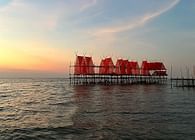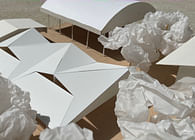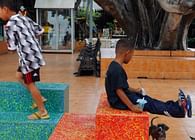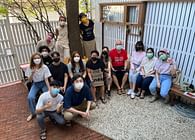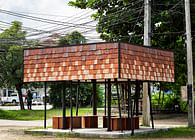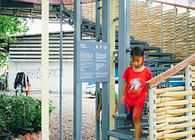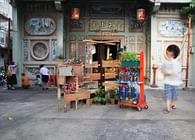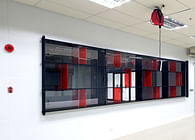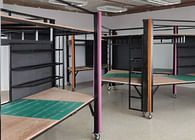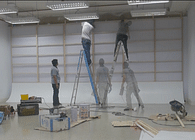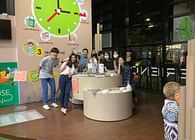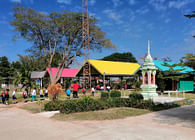
Home is where the heart is. Does it really mean that, apart from the physical presence, there is the possibility to inhabit almost every space with a bit of love and care? Every website and application has a home button too, always taking us safely to the welcoming interface. Seeking home requires to take a mental, physical and digital journey through landscapes, policies, real-estate manifestations, commissioned architectural projects, Ikea catalogs, ads, aliexpress offers, renderings, condo expos, second-hand classifieds - all made to order, buy or rent within the sweet spot of our budget. Capitalism as a driving force for the economy accelerates the housing crisis reinforcing and producing new extremes - leaving ones with various real-estate assets in portfolio and others in compromised conditions, from tiny apartments to homelessness. With recent pandemic events, the home became a shelter, burden, necessity, office, studio, warehouse, bakery. The home remained absent, became dysfunctional or a comfort zone - depending on the current material, emotional, and family situation. With the lockdown, human perception moved towards the interior of the apartment, analyzing the softness of the sofa or chairs, room layout, the performance of kitchen equipment, or overall space functionality - studying its acoustics and light qualities. Emotional aspects of space, relationships between the inhabitants became an important factor, dividing or opening one’s space further. With isolation, the steady image of the home gradually dissolved, opening the question to the world population what the home is and what it actually may be. How we make home through interactions, informal agreements, trends, online orders, digital tools, desires is changing. What do we seek? Being apart became the new ground for research, experiment, and play, as students were looking for new definitions of what makes space a home.
Home is Design & Build 2020 focused on studying Bangkok's real-estate and personal, emotional landscapes of spaces we inhabit. Merging virtual with built, material spaces, students proposed fictional and transformable installations in the form of DIY-home-kit parcels to discuss what home is or could be for them. Studying how we live, students explored personal, cultural, social, and economic imaginaries of the idea of home and housing. Students examined both 1. their own households, rituals, comfort zones, dreams and 2. cinema (documentaries and fiction) outlining unique scenes and moments to propose new sets of actors, rules, behaviors, conditions, and factors that became the framework for further studies and development of the final proposal. Through the series of in-house experimentations, students recreated and evolved those new definitions and began testing the potentials, and made observations of what home could be. Constructed and choreographed performative spaces were 3d scanned and served as initial sketches for further development and transformations. Digital tools, Virtual Reality, and Augmented Reality became important assets in building imaginaries, constructing scenarios. Through the series of 3d models, physical models, drawings, illustrations students developed prototypical space discussing individual and collective qualities, potentials, and ideas. The remote character of the workshop allowed it to immerse in nostalgia and missing relationships, interactions, however, it also allowed students to recognize new qualities of personal and shared spaces, habits, and routines that emerged from and around online activities at home. Exploring and manipulating the language of patent drawings and ikea-dummy instructions, students appropriated it as the form of internal communication and development. Incorporating the digital infrastructures and studying delivery systems as methods of exchange and planning, students built a ready-to-ship kit parcel as their final project. Research, drawings, graphic materials took the form of manual/publication, attached to the parcel. With a relaxation of the safety measures in Bangkok, students found a hidden space in a heavily commercial district with no housing called Siam. Retail space was transformed into the fictional home/room where the installation/home-kit was exhibited and inhabited through the course of the week. Meeting peers, friends, playing games, having food together, and inhabiting remotely created projects became a unique experience for everyone and a place for the celebration of missed moments. The exhibition was also the movie plan, were scripted and improvised acts of inhabiting the space were recorded and compiled into the movie. Previously created virtual spaces and 3d imaginaries became the extension of the room, blending multiple forms of narration into video diaries.
Status: School Project
Additional Credits: Students:
Natalie Pirarak Tang
Slin Smakkamai Kana
Natcha Thanachanan Plern
Nicha Vareekasem Toon
Nisama Lawtongkum Knink
Raphadson Saraputtised Hong
Sasatorn Sawansan Matemee
Panotn Chotesukhathai Arm
Pheerapitch Phetchareon Oat
Sirawich Teerasithipol PP
Collaborators:
Studio 150 Bangkok
Instructor:
Michal Jurgielewicz
